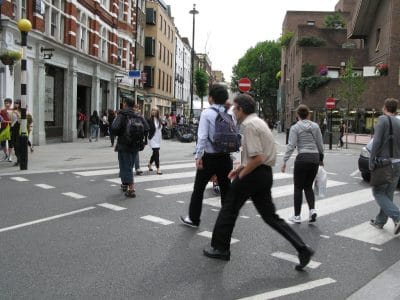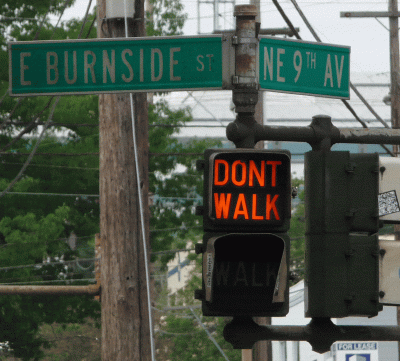 At one point or another we are or will be pedestrians. Whether we are trying to save on gas or just get some fresh air, when walking we are almost always confronted with crossing a street; we then become a pedestrian. Pedestrian is defined by Merriam-Webster Dictionary as, “relating to or designed for people who are walking.” The implied meaning of this definition involves all the different places a pedestrian could walk, including roads, bridges, sidewalks, and potentially the side of the street. There are many ins and outs to becoming a pedestrian, and while many of us would hope that we would never encounter a negative experience as a pedestrian, pedestrian accidents do happen. In 2012 the National Highway Traffic and Safety Administration reported a total of 4,280 deaths due to pedestrians becoming implicated with vehicles in one way or another. The following is a guide to pedestrian laws, what to be aware of as a pedestrian, and what to do if you have been injured as a pedestrian.
At one point or another we are or will be pedestrians. Whether we are trying to save on gas or just get some fresh air, when walking we are almost always confronted with crossing a street; we then become a pedestrian. Pedestrian is defined by Merriam-Webster Dictionary as, “relating to or designed for people who are walking.” The implied meaning of this definition involves all the different places a pedestrian could walk, including roads, bridges, sidewalks, and potentially the side of the street. There are many ins and outs to becoming a pedestrian, and while many of us would hope that we would never encounter a negative experience as a pedestrian, pedestrian accidents do happen. In 2012 the National Highway Traffic and Safety Administration reported a total of 4,280 deaths due to pedestrians becoming implicated with vehicles in one way or another. The following is a guide to pedestrian laws, what to be aware of as a pedestrian, and what to do if you have been injured as a pedestrian.
Table of Contents
Pedestrian Laws
Pedestrian laws are different in every state and vary in their severity and who claims fault if an accident does occur. The follow is a list of Utah laws that have been set in consideration to vehicles for pedestrians.
Turning vehicles must yield:
All vehicles who are turning must yield to the pedestrian who is walking. If a car is turning left and they have a green light they must still yield to any pedestrian, even if they are not directly in the way of the vehicle who is turning. If a car is turning right they must also yield whether they have a red light or a green light to turn.
Yielding in general:
In all other instances drivers must take the precaution to yield to pedestrians. (Per Utah code this is found in 12.76.050) When cars approach a crosswalk they must cooperate with the crosswalk by coming to a full and complete stop. This must occur whether the pedestrian is in the current vehicles lane or the adjacent lanes (including the opposite lanes if feasible). Vehicles must also make every effort to not obstruct the path of a crosswalk or a pedestrian. If a car is turning and crossing a sidewalk (such as turning into a driveway in a residential area) they must first yield to the pedestrian who is crossing the sidewalk.
Buses with flashing lights:
Vehicles must yield to any bus that has flashing lights due to the fact children could be crossing the street. Failure to stop for the bus could result in a ticket or accident. All buses are mandated to have working and flashing lights that are always visible to the vehicle. Drivers must not proceed through the area across from the bus or the lights until after the stop sign has been lifted or the lights stop flashing.
In consideration to the pedestrians themselves, the following is a list of Utah laws.
Crossing as a Pedestrian:
Pedestrians should only enter a crosswalk when it is legally marked and they have looked for approaching vehicles or other obstructions. This includes a pedestrian tunnel and even overhead walkways. If there is none of these options available to the pedestrian (there is not a crosswalk or the furthest one is more than 700 feet away) walkers can look both ways and cross if they feel so inclined.
Following Signals:
All pedestrians must appropriately follow the signals exhibited by the walk signs attached at most crosswalks. If the signal asks the pedestrian to stop, they must appropriately stop. If the sign asks the pedestrian to walk they are more then welcome to do so. Pedestrians should also be aware of the countdown timer which signifies when they can no longer walk.

Being an Aware Pedestrian:
Being a Pedestrian also implies being aware of what is around you and being aware of the potential consequences of crossing the roadway. If you choose to walk in the crosswalk without the proper signals you could potentially be injured. When you enter a roadway without the proper signs you yourself could also be subject to legal obligations. Such legal obligations including jaywalking. Jaywalking is a slang term for illegally crossing the street when you could use legal means. Pedestrians must be aware that vehicles are constantly in motion and making different decisions. When you pair this with the high rate of distractions that now occur on our roadways (music, phones, and even other passengers) pedestrians should never run the risk of crossing a street.
Pedestrians should also be aware of traffic conditions and the potential of drivers not being able to see each other. This can especially occur at night or when weather conditions are bad. Many times drivers are trying to turn or get to one place or another so they fail to see the person who is walking. The amount of speed plays a direct factor into how injured a pedestrian can become if they are hit by a car. Deaths do not always occur from high speed crashes, in fact if a car hits a pedestrian any amount of damage can ensue from any amount of speed. If pedestrians are walking at night they should wear brightly colored clothing so cars can spot them.
If You Have Been Hit:
Unfortunately, there are plenty of stories which relate to pedestrian accidents. The most recent accident in Utah occurred at the end of October when a pedestrian crossed illegally and was struck by a SUV. Many times the fault is not always clear, the best policy is to stay and help the pedestrian if you have accidentally hit them. Call the appropriate emergency numbers to make sure they are safe.
If you are on the other side of the accident and are a Pedestrian who has been injured, give us a call at Christensen and Hymas where we can give you the advice you need, to give you the compensation and justice you deserve. Call us today at 801-506-0800.